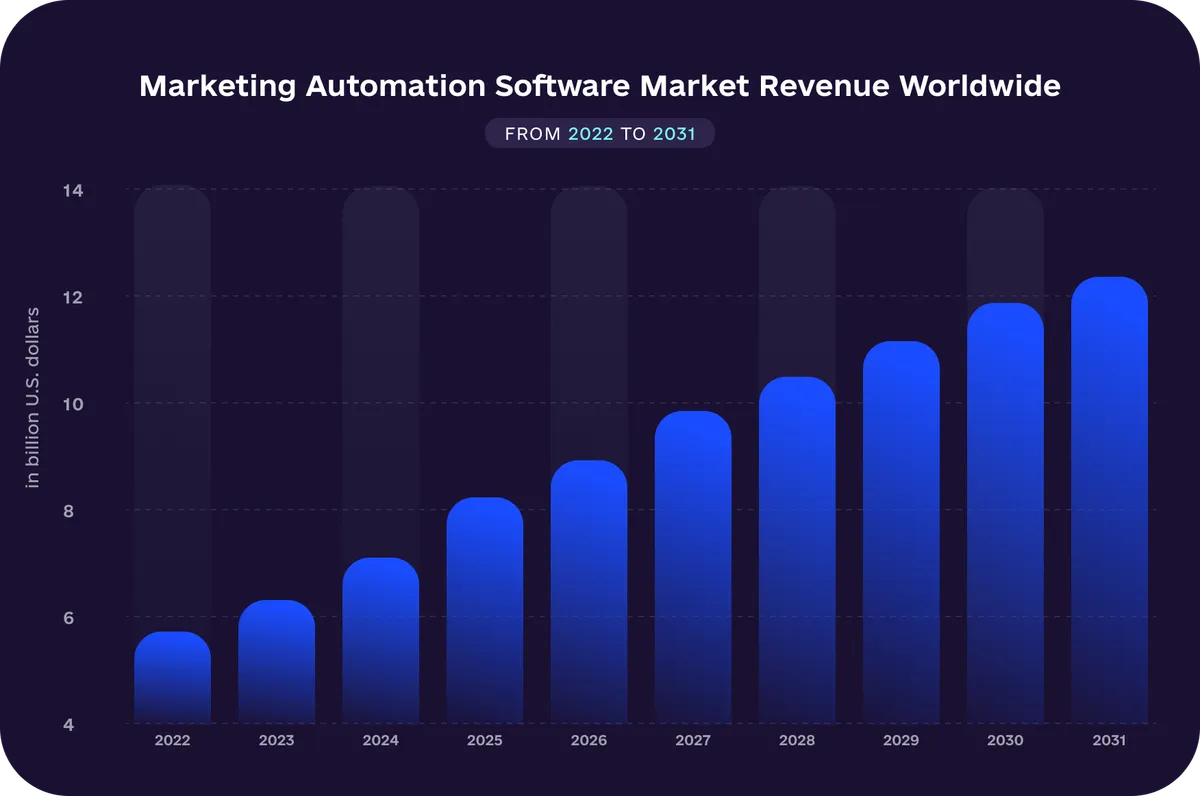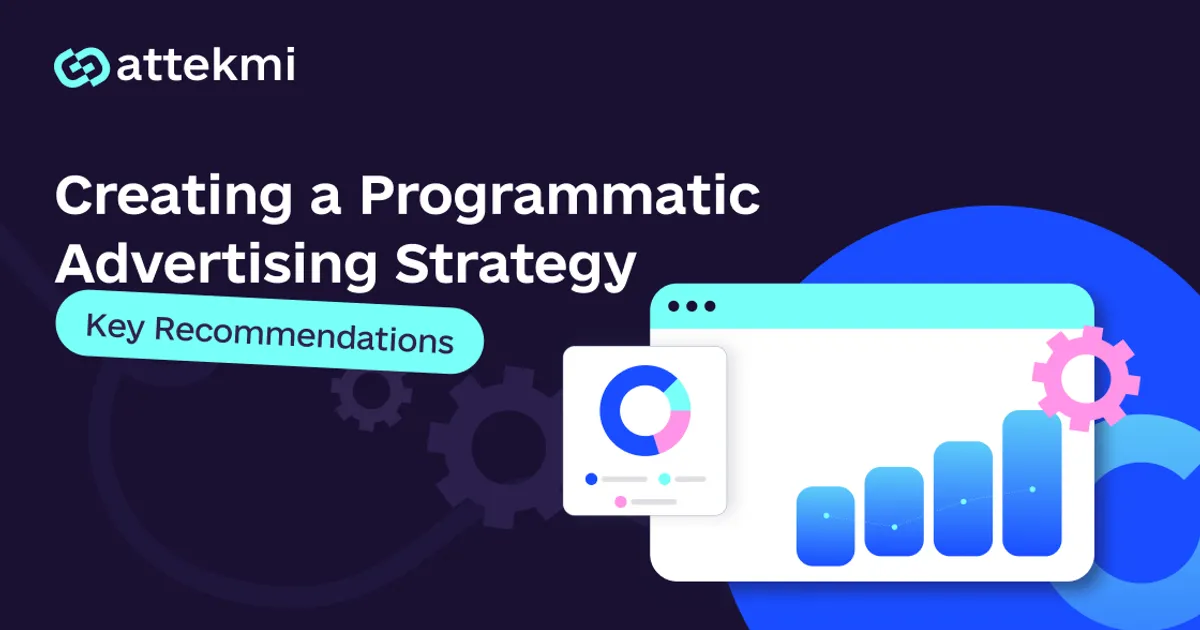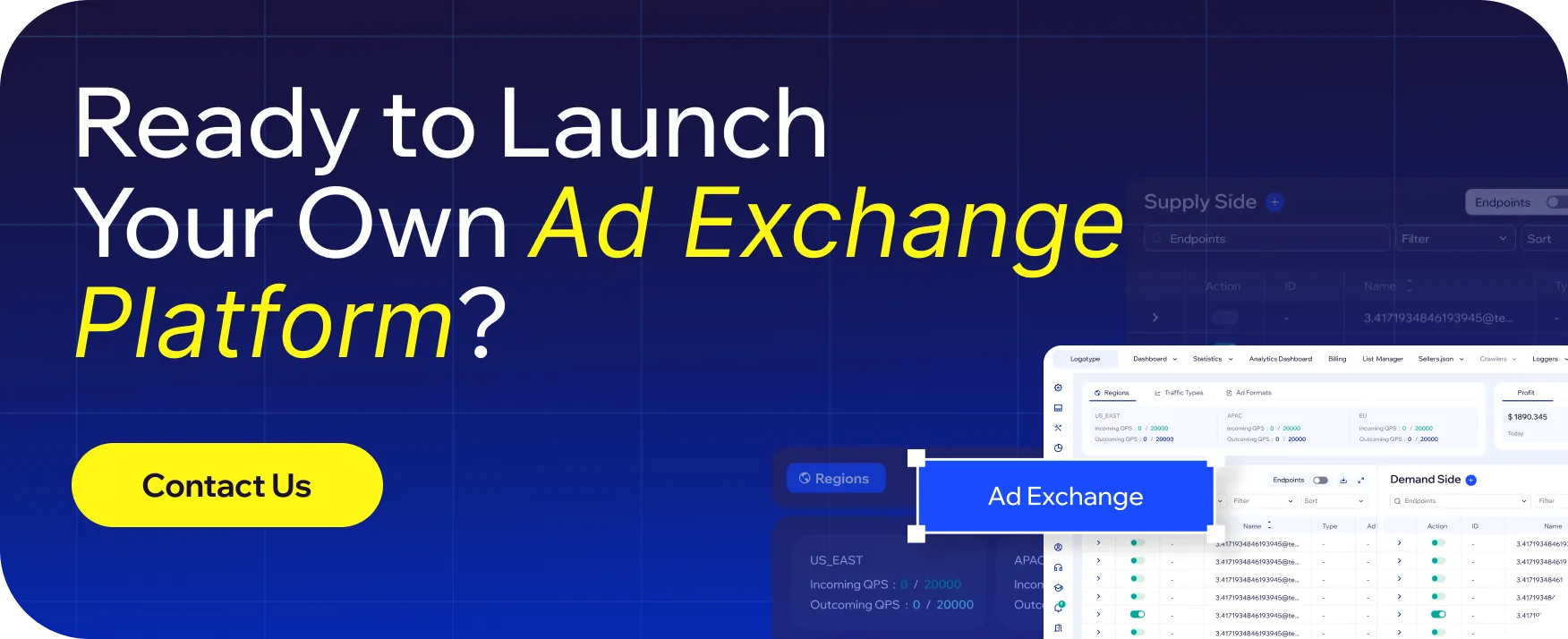Due to the severe competition in the market, getting customers’ attention is a task that becomes more challenging every single year. And that’s not only about competition – people have their attention pulled away by all kinds of content and gimmicks all the time. Both these factors have a strong impact on digital advertising. Marketers have to come up with more effective advertising strategies to get their messages to their potential and existing customers.
Programmatic advertising technology comes as a solution to this challenge. It uses automation and software to determine and target ads to more high-converting audiences. Imagine a system that launches a campaign, measures the results, determines who likes the ad, and shows that ad to people just like the booming segment. That innovative approach helped the programmatic ads sector make over $455 billion in 2021. That number could reach almost $780 billion by the end of 2028.
In discussions around programmatic advertising, the topic of adtech vs martech often arises. While adtech focuses on the technology and platforms directly related to advertising, martech covers broader marketing technologies. Understanding the distinction between these two can help marketers optimize their advertising strategies and integrate the right tools into their campaigns.
How to do programmatic advertising in the right way? Launching effective campaigns requires more than choosing the right demand-side platform. It is also essential to prepare a strong programmatic ads strategy. This guide will help you do this, so keep reading to learn more about programmatic advertising examples and best practices.
Key Takeaways
A strong programmatic advertising strategy enables brands to reach high-intent audiences with precision, automate media buying, and optimize ROI through data-driven decision-making.
Key tactics include selecting a DSP with robust targeting and analytics capabilities, setting up precise audience segments, and delivering ads through an omnichannel approach across web, in-app, CTV, and DOOH.
Ad creatives must offer value (education, entertainment, intrigue) and use strong hooks to drive conversions and user engagement.
Continuous campaign analytics, brand safety controls, and contextual targeting are essential for sustainable success in a privacy-first environment.
Attekmi helps businesses launch ad exchange platforms in the shortest time possible.
With Attekmi’s ad exchange solutions, clients like Mobupps achieved 371% ROI and 207% revenue growth, showcasing the power of owning and managing your own programmatic infrastructure.
What makes a strong programmatic strategy in 2025
To deliver measurable results, programmatic ad strategies must combine clear objectives, data intelligence, and transparent technology. First and foremost, you should define your goals and specific KPIs. The next step is to activate first-party and contextual data to build privacy-compliant audience segments.
Besides, in 2025, the tech stack should go beyond a demand-side platform – leverage clean rooms and AI-driven optimization for precision and efficiency. For effective measurement, use unified attribution models and attention-based metrics to track performance across devices. Last but not least, be transparent regarding data usage and optimize your supply chains to build trust and ensure brand safety.
9 best programmatic advertising strategies
Navigating the realm of programmatic advertising requires a deep understanding of its mechanics and benefits.
How to build a programmatic strategy? Our extensive experience has honed our ability to orchestrate campaigns that leverage our targeting pool with precision, automation, and data-driven insights. This holistic approach maximizes the impact of each advertising initiative.
Our journey with programmatic advertising has been a continuous learning process, resulting in a refined playbook for success that we’re eager to share. Whether you’re seeking brand visibility or ROI optimization, our programmatic expertise stands ready to elevate your strategies. Let’s harness the power of programmatic advertising together for unparalleled success.
Additionally, explore what is supply path optimization, and top-3 strategies for achieving success in programmatic advertising campaigns.
1. Select the right DSP
Before you start launching programmatic campaigns and fine-tuning your strategy, you need to select an effective demand-side platform (DSP). There are multiple options to choose from, so here are several things to pay attention to:
Supported ad formats and environments – the more options are available, the better
Targeting and filtering settings – again, the more options a platform has, the easier it will be for you to reach your target audience
Budget-related features (is it possible, for instance, to limit day spending?)
Performance optimization capabilities
The selection of bidding models
The quality of publishers who have partnerships with this DSP
Analytics features
The quality of customer support
After you find the right DSP, you are ready to take the next step.
Why it matters: Making the right choice is a crucial step in terms of building an omnichannel strategy, optimizing campaign performance, and maximizing ROI.
2. Set up targeted demographics
The next step is actually nothing new under the sun but golden in its effectiveness nonetheless. Like any other programmatic marketing strategy, programmatic advertising starts with setting up ads with targeted demographics. As fundamental as this step might seem, it’s still alarming how many companies say that “everyone is the target market” and waste thousands, if not millions, in wasted ads.
Being specific with one’s demographics is key to getting relevant traffic and improving conversion rates. It gives a good starting point and allows the ad to collect better information and inform measurable results. Demographics can be targeted based on a person’s age, preferences, gender, income bracket, location, etc.
Why it matters: Proper targeting enables you to reach exactly those users who are most likely to get interested in your products or services, which is a way to increase the conversion rate and sales.
3. Target behaviors
Another rising best practice in the advertising sphere is behavioral targeting. These behaviors could include visiting a website, clicking on a button, viewing a specific social media profile, liking a post, watching a video, etc.
Programmatic advertising tools can help track people’s behaviors and target ads based on those actions. For instance, one ad could gather information on teenagers and kids who watch Marvel movie trailers on YouTube and Facebook and retarget ads that promote Marvel character merchandise and toys for their age group. Pairing those action-targeting strategies with specific demographics is a great combination for successful programmatic campaigns.
Why it matters: Behavioral targeting enables you to deliver more relevant advertising content. However, it is crucial to ensure compliance with privacy regulations to maintain trust.
4. Create retargeting campaigns
Many programmatic advertising platforms do more than just target ads. Another feature one must learn how to use is setting up ads with strong retargeting programmatic campaigns. It’s not news that people don’t always buy at first sight of an advertisement. But if a brand could build up a set of ads in the correct succession, it could improve brand awareness and turn that familiarity into a sense of curiosity or liking.
Programmatic advertising retargeting makes it possible to talk to multiple prospects with a fully customized roadmap for each based on a retargeting campaign. Here’s what that might look like. Let’s say you target two people with the same ad for a running shoe brand. One clicks on the ad while the other closes it automatically. The programmatic ad system can track that and take two different approaches. The first one — the person who clicks— will get a discount coupon to close the deal on the shoe they clicked on. The second person who exited could receive an offer from a different shoe brand that could meet their needs. These are just some examples of great retargeting strategies.
Why it matters: Retargeting allows you to reach users who have already expressed certain interest in your brand and are more likely to convert.
5. Maximize your creatives and content
Many types of programmatic ads could help create better conversions and results. But the approach isn’t the only key to a good digital marketing strategy. One has to have good content too. Sometimes, ads fail not in the targeting strategy or demographic building. It’s in the content itself.
An important question to ask is “does this ad creative add value to my audience?”. The holy trinity of advertising value is as follows:
Education — Will people learn something new or feel enriched?
Entertainment — Does the content entertain the audience?
Intrigue — Does the ad spur curiosity?
Therefore, follow these programmatic creative best practices to ensure greater performance.
Why it matters: The digital advertising ecosystem is highly competitive, so optimizing creatives and content is essential to stand out from the crowd and drive engagement.
6. Set up strong hooks
Developing a strong hook is also on the list of the most effective programmatic advertising tactics. It’s not just enough to put a “buy now” button. Create a compelling reason for people to act now. When leads delay an action, there’s a big chance they’ll never take it— whether it’s subscribing, buying, or joining. Creating a sense of urgency by putting in a timed offer or making them feel like acting as soon as possible is the best decision.
Why it matters: Strong hooks allow your ads to capture attention quickly, improve ad recall, drive brand awareness and recognition, and increase both the campaign performance and ROAS.
7. Reach your audience in an omnichannel way
Programmatic advertising enables you to reach your target audience in multiple environments. Apart from smartphones and laptops, you can deliver your advertisements via CTV and digital out-of-home (DOOH) devices. The variety of formats is also impressive: native, video, banner, programmatic audio advertising, and other options allow you to reach your customers in a diverse and creative manner. Therefore, do not limit yourself to a specific channel or format. Experiment with environments and formats to detect opportunities. However, it is essential to remember that your brand should be recognizable regardless of your choices, so follow the omnichannel approach.
Why it matters: An omnichannel strategy allows you to reach your target audience at every touchpoint, which is a way to ensure a seamless experience and maximize ROI.
8. Prioritize brand safety
To build trust and increase the conversion rate, your programmatic ads should appear in safe environments. To ensure brand safety, select a demand-side platform that cooperates with authorized and reputable publishers. Additionally, many DSPs allow advertisers to create white and blacklists of publishers – apply these settings to protect the image of your brand. It can also be useful to leverage contextual targeting. First of all, it is one of the tactics in programmatic advertising that helps launch campaigns while still respecting user privacy. Secondly, with contextual advertising, your ads will appear next to relevant content, which is one more way to keep your brand safe.
Why it matters: Prioritizing brand safety enables you to build trust and minimize the risk of ad fraud. As a result, you will receive valid traffic, while your conversion rate will grow.
9. Analyze continuously
To be able to maximize the performance of your programmatic campaigns, you need to analyze them continuously. Doing so will allow you to detect not only weaknesses but also opportunities. Additionally, thorough analysis with a focus on prioritized KPIs will help you understand if you are achieving your marketing objectives.
Why it matters: Continuous analysis is key to effective programmatic strategy optimization. Otherwise, you will act blindly.
Programmatic advertising as the future of ads
The future of programmatic advertising looks promising. Programmatic advertising now makes up over 80% of the digital ads spending pool. Moreover, we could look at a time when automation and programs rule the digital advertising world. In the near future, this development could propel brands to the next level of awareness, authority, and profitability.
By the year 2031, the revenue of the worldwide marketing automation software sector is anticipated to exceed $11.2 billion by 2031.

Out of the million websites experiencing the highest traffic, 3.3% incorporated header-bidding technology as of October 2023. This figure rose to 10% among the top 100 thousand websites and surged further to 15% within the top 10 thousand websites. This means that despite the programmatic advertising market’s large scale and rapid development, it has a huge potential for further growth and advancement.
Projected to expand at a CAGR of 11.2% from 2023 to 2028, the Digital Signage Market is poised to achieve a substantial size of $27.8 billion by 2028. This growth surge can be attributed to the escalating need for digitized product and service promotion, a powerful method to captivate the desired audience effectively. Moreover, the rising demand for 4K digitized sign displays coupled with embedded software and media players is driving market demand, offering an affordable Ultra HD digital signage solution to customers.
3 secret tips about programmatic strategies from the Attekmi team
Creating an effective programmatic ads strategy may be challenging if you are only entering the world of programmatic advertising. However, at Attekmi, we are always ready to help. We offer AdTech and Ad Ops team training and outstaffing digital ads operations services. Custom AdTech development and ongoing support are also on the list of what you can count on.
Additionally, we offer ad exchange solutions to businesses that would like to start driving media trading income. With us, Mobupps achieved 207% revenue growth and 371% ROI. You can explore this and other case studies of our partners here.
For now, we would like to share more programmatic best practices with you. Take a closer look.
Personalization is key
Most people hate seeing ads. They use ad-blocking software and have so-called banner blindness. Therefore, preparing more creative ads than your competitors is not enough. You need to strive for personalization. If your messages resonate with your audience, users will be more likely to interact with your ads and convert.
Try A/B testing and dynamic creative optimization (DCO). Additionally, make sure to segment your audience into smaller groups. In this way, it will be easier for you to create unique and personalized advertising content.
Keep an eye on trends
The programmatic industry evolves continuously – new tendencies and opportunities enter the stage regularly. Considering this, it is crucial for you to monitor trends. Being aware of what is going on in the industry implies being able to react quickly and overcome your competitors.
Obviously, not all the trends are a must to follow. However, if you keep an eye on them, you will be able to collect some valuable programmatic ideas for your current or future campaigns.
Consider getting your own ad exchange
All the programmatic tactics listed in this guide can help enhance your advertising strategy, drive conversions, and increase income. However, there is one more thing that you may want to do – getting your own ad exchange platform.
By doing this, you will be able to connect your selected demand-side platform to the most relevant supply-side platforms. You will be in full control of everything, which can help you reach your goals in a more effective way.
Besides, launching your own ad exchange solution does not mean the need to invest in development from scratch. There are ready-to-use platforms available – like those offered by Attekmi. With one of them, you can enter the market in the shortest time possible and start not only to advertise more effectively but also to earn on media trading. Whether you need a basic solution or a platform to support your enterprise programmatic strategy, we’ve got you covered.
Strategy considerations for advertisers vs publishers
Now that you know the most effective programmatic advertising strategies, let’s explore the key considerations for both marketers and media owners.
In 2025, advertisers should prioritize data ownership, cross-channel audience activation, and measurement consistency. Investing in first-party data strategies, AI-powered bidding, and privacy-compliant targeting ensures accuracy without reliance on third-party cookies. It is also important for marketers to evaluate supply transparency and focus on incrementality and attention metrics to understand the real impact of their campaigns.
In turn, publishers should focus on inventory quality, yield optimization, and direct relationships with advertisers (programmatic direct deals are beneficial for all the parties involved). This way, they can ensure a stable income and maximize revenue while maintaining audience trust. In a privacy-first world, publishers who combine strong data with transparent programmatic partnerships will attract premium advertisers and drive long-term monetization.
Afterword
Launching effective programmatic advertising campaigns can be challenging, especially for those who have never tried this marketing model before. However, with our recommendations, this task becomes simpler. Follow them to reach your goals, and make sure to monitor the performance of your campaigns continuously. In this way, you will be able to detect weaknesses and opportunities and react to them promptly.
FAQ
Everything depends on your business goals. However, according to programmatic advertising best practices, it is important to focus on improving targeting accuracy, ensuring brand safety, maintaining transparency, and maximizing ROI. It is also crucial to utilize data-driven insights, enhance user engagement, and optimize ad spend.
First of all, it is essential to define your business goals and budget, and to assess your data. Prioritize platforms that offer interoperability, real-time analytics, fraud prevention, and privacy compliance. A strong stack should integrate DSPs, DMPs, and clean rooms seamlessly – this is crucial for precise audience targeting, transparent reporting, and long-term efficiency.
In 2025, it is important to measure ROAS, attention metrics, and incremental reach. Apart from impressions and CTRs, focus on cross-device attribution, conversion lift, and audience engagement quality. Advanced analytics and privacy-compliant measurement tools will provide you with deeper insights into how each impression contributes to actual results and help you ensure effective programmatic strategy optimization.
 By Anastasiia Lushyna
By Anastasiia Lushyna
